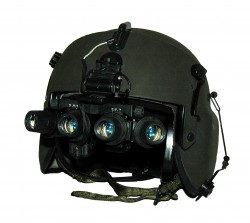The US Navy has placed its third order with Rockwell Collins and Elbit Systems of America (ESA) for a night vision cueing and display system that allows pilots to fly and fight as if it were daytime.
The system lets pilots using Elbit’s four-lens panoramic night vision goggle visually cue weapons and sensors and see head-up displaysymbology in the dark, giving them the ability to engage in high off-boresight air-to-air shots and air-to-surface strikes as they would visually during the day.
Under a$21 million ceiling contract awarded by the navy last month, theRockwell Collins-ESA Vision Systemsjoint venture will produce120 Joint Helmet Mounted Cueing System (JHMCS) Night Vision Cueing and Display (NVCD) systems, and 30 helmet-mounted display test sets.
ESA president and CEO Raanan Horowitz tells Flightglobal that the navy has already ordered 220 NVCDs, bringing the total to 340.
The navy lists the night vision cueing and display system as achieving initial operational capability in December 2012, while full operational capability is expected this December.
“The US Navy has been using the NVCD over the past couple years in various operational settings. We have supported these deployments and received positive feedback from the customer and the users,” says Horowitz.
The night vision system is produced by Elbit in Merrimack, New Hampshire, with several components supplied by Rockwell Collins and ESA’s Israel-based parent company Elbit Systems.

Elbit Systems of America
Horowitz says the navy’s NVCD is based on the company’s QuadEye Panoramic Night Vision Goggle (PNVG) that is designed for US rotary and fixed-wing pilots.
QuadEye goggles provide a 100° by 40° wide-area picture through four splayed 16mm image-intensifier tubes, according to Elbit’s product specifications.
Rockwell’s Joint Helmet Mounted Cueing System is used by pilots operating the Boeing F/A-18, F-15 and Lockheed Martin F-16.
The Rockwell-Elbit team offers an international version of the night vision cueing and display system for F-16 users, although it is based on the twin-lens Exelis F4949 night vision goggle.
Source: FlightGlobal.com























